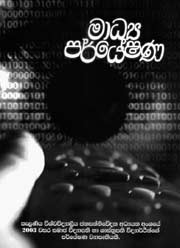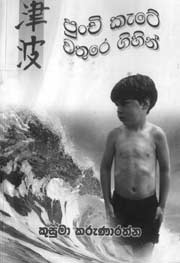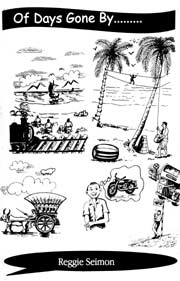|
DAILY NEWS ONLINE |
|
|
|
OTHER EDITIONS |
|
|
|
|
|
|
|
|
|
OTHER LINKS |
|
|
|
|
|
|
  |
|
Rich source for creating community awarenessMadhya Paryeshana Edited by Dr. Ariyaratne Atugala Ratna Book Publishers, Colombo 10 294 pp. Price Rs. 425
All the research articles are in Sinhala, except three, that are in English. An identical pattern of writing according to a given format is observable in several articles. The essential elements of a research paper are the key aspects of each paper. The subjects cover several key issues relating to the written and the electronic media. Each paper could be critically examined, analysed, interpreted, evaluated and make judgements. The written papers could be examined according to their style of presentation, semiotics (meaning) and metaphor. All the articles may be included in the domain of cultural studies and the writings are meaningful because of their originality and context. There are two articles that are quite different from the other texts. One is on the aspects of communication of the Nataraja image (Image of God Siva) by B. M. S. Soyza and the other is on the qualitative aspects of the Buddha's style of communication by H. S. B. Gunawardena. These two papers reveal the interpretative strength of the researchers and their abilities in filtering the concepts from resource materials. The paper by Lalith Liyanage on the "safe bottle lamp" is also different from the other papers, in its content and approach. The risks of bottle lamp accidents leading to disfigurement, deformity and death are still a challenge to positive health in the poor rural periphery. The particular advertisement on promoting the use of the safe bottle lamp by depicting a devil being imprisoned in the bottle lamp tries to imbibe inspiration from our traditional folklore. Lalith Liyanage describes this advertisement as one that appeals to the intellect and not the raw senses. It impinges the faculty of conception more than perception. While carefully reading these papers, the reader would be developing critical concepts about communication and language in particular. Critical concepts can be thought of as filters that bring some features of meaningful communication to the fore, while relegating other dimensions of meaning to the background (Jodi R Cohen, 1998). Further, in-depth scrutiny of the topics and subject matter in this anthology reveals the nature and scope of the current information society and the extent of technical innovation around us. In that sense, "Madhya Paryeshana" is a rich source for creating community awareness over the inter-disciplinary nature of media communication. - Dr. Senarath Tennakoon Semi-fictitious tsunami storiesPunchi Kete Vathure Gihin Author: Professor Kusuma Karunaratne Published by: Wijayasuriya Grantha Kendraya Price: Rs. 130
Yes you can. Because the stories in Punchi Kete Vathure Gihin are semi-fictitious. They are as Prof. Karunaratne states in her preface, imaginary tales based on real life incidents. This is surely one of the redeeming features of the book, especially for those who are ultra sensitive to sorrow and, for those who feel there are times when it's good to have time rushing past you, when it's good to forget things, especially those aspects of the past that hurt you deeply. Why give more strength to sorrow? But the craftsmanship of the author is such that even for those who feel the pain of others as deeply as though it's their own pain, Punchi Kete is readable. This is so if they begin to read the stories keeping in mind not only that, as Chekhov said and as Prof. Karunaratne quotes in her preface, a short story might be a "slice of life" and life could be hard as Lieutenant Colonel Vershinin says in the Three Sisters (once again by Chekhov) "but we do have to admit it is getting clearer, brighter and in all probability the time is not far off when it will be absolutely radiant". From the first story to the last the focus is the tsunami. From the word go the reader knows one or the other of the characters is going to die or lose their loved ones or their property to the tsunami. But, in spite of this lack of subtlety one is made to continue reading, feeling exactly the way Martin Wickramasinghe felt when he read Dostoevsky's Crime and Punishment, as if someone is sawing one's brain apart. Thus each story has a poignant, unforgettable moment from the death of a monk on his way to an alms-giving who has come to terms with the inevitability of death ("we must depart from this world when the oil runs out of the lamp") in the opening story, to baby number 21 who learns from her aunt how she escapes being a tsunami orphan, to the grandmother who admonishes her granddaughter when she bids her farewell by saying "Yannam" (I'm going), when she ought to have said "gihin ennam" (I'll come back) each story mists the eyes, brings a lump into your throat and makes you doubt if Colonel Vershinin's prophesy of a clearer, brighter life ahead will ever come true. Yet, with a brave-heart you turn to the next page, only to realize the story told therein is even more painful than the one before. So, what do you do? Continue? I confess. I have managed to read only upto the story titled Ekai, dekai, thunai (One, two, three). I give up. Bravo to anybody who has the courage to continue. But whether you do or not, one thing is guaranteed. After reading at least one, of Professor Karunaratne's maiden collection of stories you will never be the same again. Here's a book which has the power to penetrate anybody's consciousness, however immune they may feel they are towards pain and sorrow, in a way no other book on the subject would manage. - Aditha Dissanayake Antidote to boredomOf Days Gone By ... Author: Reggie Seimon
Its frontispiece cover depicts a few caricatures illustrating some of the relevant anecdotal scenes. The author's inimitable free flowing style of writing enhances the varied aspects of his nostalgic reminiscences of past incidents and experiences. Humour The narratives are couched in simple meaningful word patterns that seem to condescendingly touch on acts and interactions of human foibles. A lively sense of humour is discernible in all his stories in which some satirical view points too are projected in good measure. In a story relating to coastline train travel he resorts to some hilarious word play in reference to certain habits and doings of some of the seaside dwellers and beach combers, such as baring their buttocks and groins in the act of defecating and answering calls of nature at which the train travellers gaze with open mouths in the manner of unabashed peeping toms. Without using vulgar or obscene expressions the author also comments on certain homosexual gay activity of a village cycle repairer, in those far off days. In lighter vein, there is also reference to sexy humour or humour in sex as evinced by teenagers caught up in romantic moods. Amusing scenes Without being blasphemous or irreligious in anyway, he has recaptured memories of some of the amusing scenes in church and allied ritual proceedings in which he had participated as a playful brat. Some of those who in their scholastic or monastic frame of mind read philosophical and abstruce stuff the whole time would sometimes get headachish with swollen headed assumptions. The spontaneous outflow of wit and humour that forms the entirety of the contents of this book would undoubtedly give such heavy headed readers some sprightly relaxation that would in turn invigorate their senses and demeanour to some appreciable vitality. These fun filled stories of innocuous humour will do a world of good for their lassitude, if any. The stories in general contain sunshine and sparkle and not gloom or inclement weather conditions. Reading them is fun and enlivening as well. Finally - going beyond my review of the book, I would like to make mention of the fact that it is a matter for surprise as to how the author was able to find the time and leisure to bring about this most captivating story book amidst all his dedicated specialist ophthalmic consultation and surgery practice at Kandy Suwa Sewana. With a truly self effacing manner Dr. Reggie Seimon has not made any reference in his book as regards his status and achievements in the medical field. This in itself is a rare praiseworthy trait in the context of self glorification indulged in, by most - professionals. On the rear of the book's backcover there appears a statement the opening sentence of which says - "The author lives in Kandy with his one and only wife". This too adds to the already extant hilarity in his stories. - R. M. A. B. Dassanayake Access to knowledge and appreciationSelected Writings Author: M. B. Mathmaluwe Publisher: H. M. R. Ellepola Pages: 202 M. B. MATHMALUWE a well-known free lance writer who often contributes to journals and periodicals has brought out several dozens of his valuable writings on numerous subjects ranging from art, archaeology, irrigation, literature, religion, history to sociology, into a well compiled collection. Broad sweep of such subjects woven into this volume summons a reader of any class or level to find something worth to read, digest and search. Of the vast area of critical and creative writing he had covered what one strikes most are the articles delving into literature, English literature in particular. Wuthering Heights of Emily Bronte, her first and the last, the writer calls it a genius and a vast drama of towering and often conflicting passions that seem to stop at nothing until they burn themselves out in despair. It creates an awareness of life, as any great tragic drama does, through contemplation of human suffering and grief that beset human life. His writings on Buddhism is thought-provoking and offer an opening to the reader to a deeper divergent search for more material on the subject of his focus. For instance, Dukkha in Human Life and "Did the Buddha Visit Sri Lanka" throw a new light for a study from a different perspective within the context of widening horizon in comparative study of other sources. Similarly, he has set his eye piercing through the compositions of Robert Frost who is considered the foremost American poet. The creed of American poets who rose to heights are limited to a few and among them Frost is unique. The writer identifies him as one full of creative talent, clarity of thinking and dexterity in handling the langauge. He is a poet of universal import unlike the other famous American poet Whitman in whose poetry regionalism prevails. M.B. quotes one of Roberts Frost's famous poetic lines: "Forgive Lord, my little jokes on thee And, I'll forgive thy great big one on me" His religio-political focus on the patriot Walisinghe Harischandra as an anti-colonial anti-imperialist hero and Martin Wickramasinghe as a novelist who treated Sri Lankan socio-economic revolution both historically and culturally in his famous trilogy in a short but deep study of two different personalities and their works and subscription from two different angles. The two of them have been historically entrusted with two distinct but vital tasks which, they fulfilled admirably, and eventually wrote themselves into the island's religious and literary history. His scholarly tribute to Sigiri Graffiti in preference to the sensibility and beauty of Sigiri Damsels in his Testament to a Nation's Aesthetic Sense is overwhelmingly a truly critique. As in any other form of folk poetry, the Sigiri folk poets drew inspiration mainly from their personal experience. M.B. points out how simple, rustic and earthly their feelings are. Hail, thou there is a flower in your hand And, a gentle smile on your face In what manner can I sustain my heart When you don't speak something sweet to me Knowledge and information Art and the artist dominate the writer's intellectual and appreciative approach in dissemination of knowledge and information. Artist's responsibility to society and evolution of Sri Lankan performing arts are two absorbing write-ups he has forcefully advanced in this volume of scriptual material to illustrate his deep commitment to art and its impact on society. Emphasising the point that promotion of righteousness is the prime function of art even when the apparent purpose as in music, singing and dancing is pleasure and entertainment, he says it is always carried with a pervading undercurrent of a moral purpose within. Dealing with the evolution of arts, he highlights the changes taking place in lyrical rendering, musical composition and vocal delivery leading finally to irresistible pop, rock, rap and also to innovative and inventive Bhatiya and Santush of today. Standing supportive of changing status of woman in history, MB traces that woman over the centuries past was gradually evolving into a liberated status from the earlier subservient standing assigned to her in the Bible being only a creature made out of a rib of man. Aristotle says that by nature the male is superior and the female inferior; therefore, man rules and woman is ruled. Kavya Shekaraya, on the other hand, tells that when husband returns home from a journey the wife should wash his feet without getting the servants to do it. Writing about women in ancient society as portrayed in history and theatre, he covers it upto her present day status in the modern world. He finally says that the true status of woman has changed and will continue to change as the years go by and they have many victories for themselves and are continuing to do so. Poetic composition On the creative plane his poetic composition Maha Gedara nostalgically recounts the life he spent in the past at his ancestral home situated in the village. Upon the threshold of home, from where My journey once began, I strain With bated breath, to hear the sound Of foot-steps or a voice, in vain The writer's extensive academic treatment of various sources and stores of knowledge and experience in analytical and visionary depth, inspires the reader to a wealth of intellectual endurance amassed by the writer. MB's application of practical experience in assimilation with what he has gathered in the process of learning, leaves the reader richer in appreciation and wiser in vision. - E. M. G. Edirisinghe |
|
|

 OVER 40 research articles on contemporary media research by
postgraduate scholars, offer down-to-earth examples that stimulate the
reader's interest on the fundamental principles of communication. This
anthology is a product of the mass media communication unit of the
Kelaniya University and is edited by Dr. Ariyaratne Atugala.
OVER 40 research articles on contemporary media research by
postgraduate scholars, offer down-to-earth examples that stimulate the
reader's interest on the fundamental principles of communication. This
anthology is a product of the mass media communication unit of the
Kelaniya University and is edited by Dr. Ariyaratne Atugala.  CAN you stand one more story about a mother and a daughter who die in
the tsunami? About a foreign family on holiday who loses their baby
daughter to the deadly waves at Yala? About a young man who grabs a gold
chain off the neck of a rotting corpse?
CAN you stand one more story about a mother and a daughter who die in
the tsunami? About a foreign family on holiday who loses their baby
daughter to the deadly waves at Yala? About a young man who grabs a gold
chain off the neck of a rotting corpse?  OF Days Gone By ... is a medium proportion running into 116 pages
comprising 28 amusing and interesting anecdotes that deserves to be
treated as an antidote for boredom.
OF Days Gone By ... is a medium proportion running into 116 pages
comprising 28 amusing and interesting anecdotes that deserves to be
treated as an antidote for boredom. 